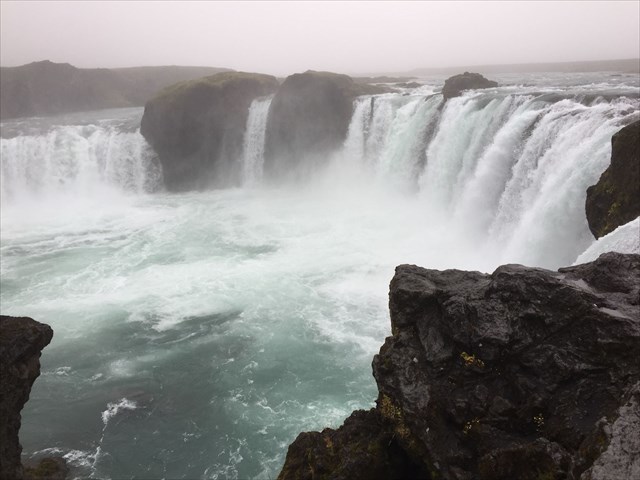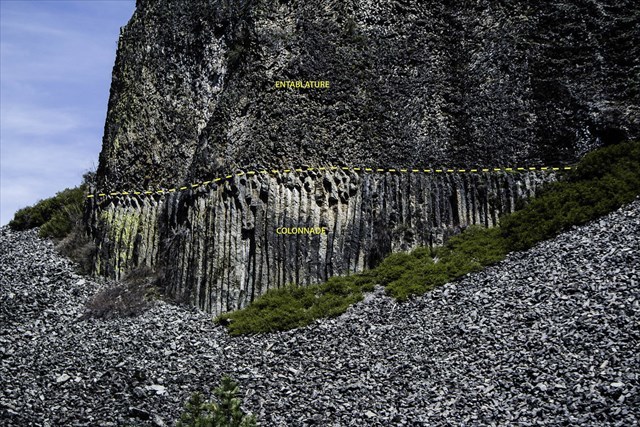
Columnar basalt at Goðafoss
Goðafoss is a waterfall in Iceland, and its name means "waterfall of the gods". The water from the river Skjálfandafljót goes from the Icelandic highland, down through the Bárðardalur valley, and then falls from a height of 12 metres over a width of 30 metres.
In the year 999 or 1000 the lawspeaker Þorgeir Ljósvetningagoði made Christianity the official religion of Iceland. According to a modern myth, it is said that upon returning from the Alþingi, Þorgeir threw his statues of the Norse gods into the waterfall. The story of Þorgeir's role in the adoption of Christianity in Iceland is preserved in Ari Þorgilsson's Íslendingabók. Íslendingabók, however, makes no mention of Þorgeir throwing his idols into Goðafoss. A window in Akureyrarkirkja, the Cathedral of Akureyri, illustrates this story.
The lava covering most of the valley is more than 8000 years old and came from the mountain Trölladyngja.
Columnar basalt
Basalt is a mafic extrusive igneous rock, which means that it is a rock formed by magnesium and iron rich lava that cools on the earths surface. Basaltic lavas cools quite quickly, which makes the rock fairly fine grained.
When basaltic lava cools quickly it can result in columnar jointing, which is a geological structure consisting of columns that are separated by joints or fractures in the rock.
The formation of columns happen because of contraction. Cooling basaltic lava contracts, since cooler things often takes up less space than hotter things. When things contracts, they often crack or fracture. If the contraction occurs at centers which are equally spaced then a hexagonal fracture pattern will develop, with 6-sided columns. However, if the contraction is not evenly spaced, then other shapes of fractures, like 5 or 7-sided fractures, may occur. The contraction does not need to be evenly spaced if the thickness and/or composition of the lava flow varies.
Water can play a role in the formation of basalt columns. If the lava flow is "ponded" in a river valley, then the water will cool the lava. The result is a formation where there are a predominantly two-tiered set of columns, known as entablature and colonnade. Colonnade are straight, but the affect of water result in irregular jointing at different angles (entablature). Entablature occurs in the upper parts of the flow, where the lava comes in contact with the water.

Basalt formation with colonnade (bottom part) and entablature (upper part). From https://www.flickr.com/photos/44740122@N08/14761684267.
The size of the columns vary, some are only a few centimetres in diameter and some are up to 3 metres wide! The size depends loosely on the rate of cooling, very rapid cooling can result in smaller columns and slow cooling often result in larger columns.
Columnar jointing can occur in other rocks. Columns have for example been observed in tuff, which is also a volcanic rock.
The EarthCache
To log this EarthCache you must visit the above coordinates and submit answers to the questions below. You do not need to wait for a response from me, it's just to send your log once you have sent me answers. If you are several who log the EarthCache it is enough if only one person sends in response, but write the nicknames of who is with and is logging the cache. If these requirements are not followed, your log will be deleted by me.
Questions
1. Look around at the basalt columns in the area. Are there mostly colonnades or entablatures here?
2. Describe the size and shape(s) of the basalt columns. For instance, how many sides do they have? Are the columns big or small?
3. Keeping your answers in question 1 and 2 in mind, describe the formation of the basalt columns here. Did it take long time? Was water present? How was the lava?
4. If you want you can take a picture with your GPS. This is not a requirement.